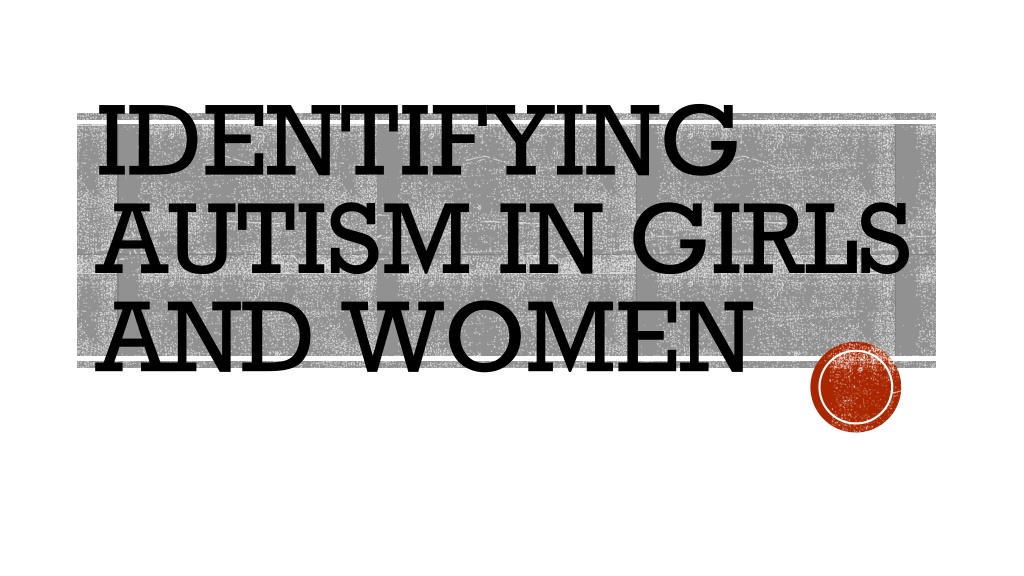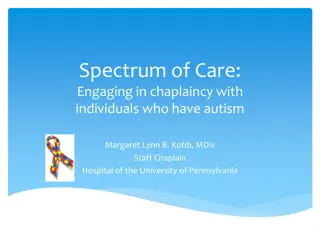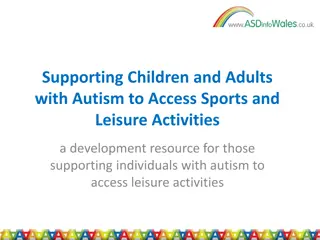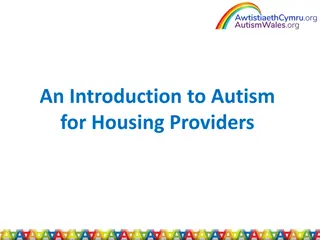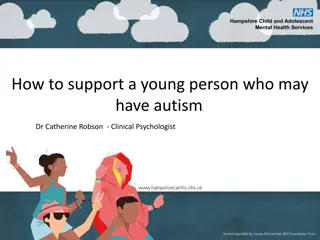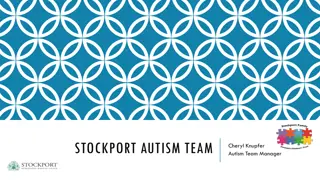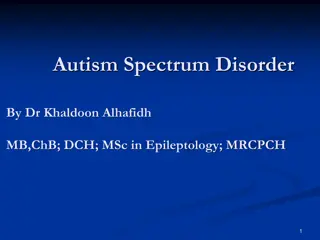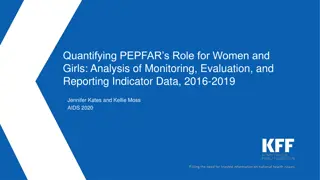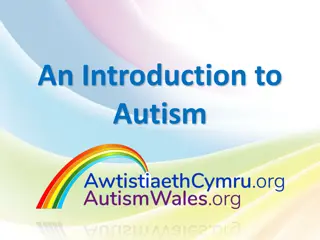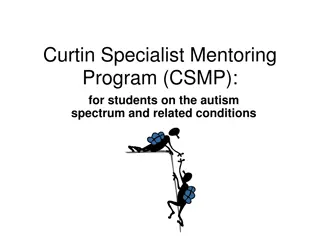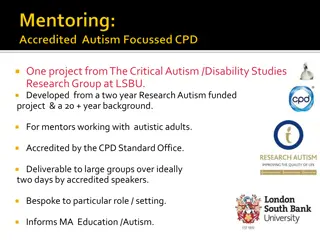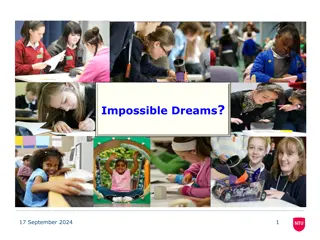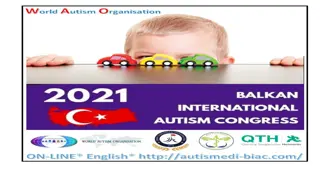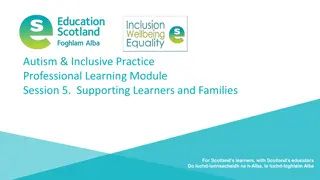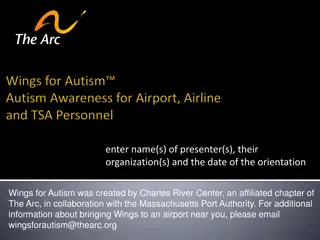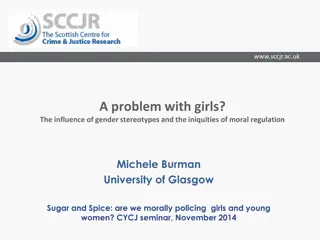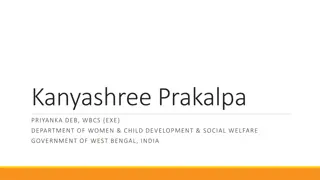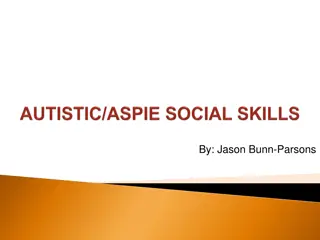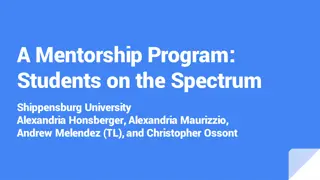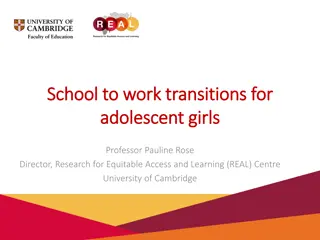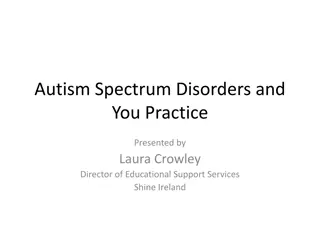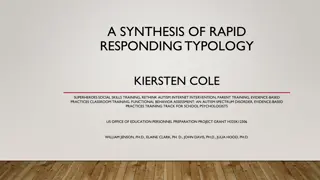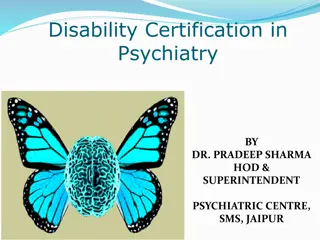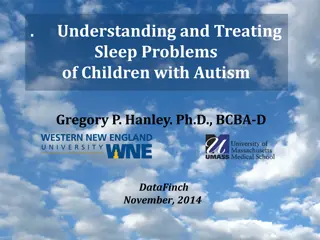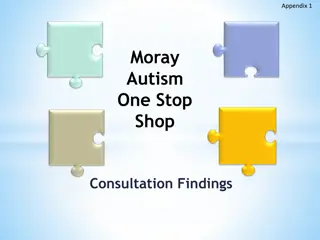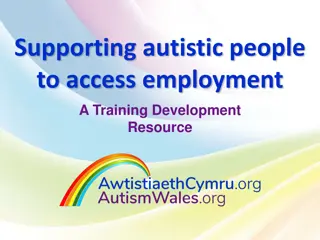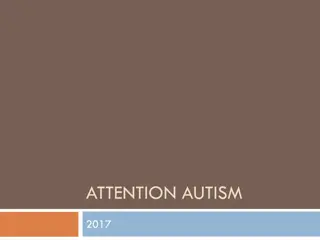Understanding Autism in Girls and Women: Challenges and Considerations
Recognizing and diagnosing autism in girls and women poses unique challenges due to gender differences in presentation, referral bias, and instrument calibration. Grunya Sukhareva's pioneering work sheds light on early observations of autistic traits in both genders. Addressing referral and instrument biases is crucial for accurate diagnosis and support. Girls' special interests may differ from boys, emphasizing the need for gender-inclusive approaches. Enhancing awareness and understanding can lead to better outcomes for girls and women on the autism spectrum.
Download Presentation

Please find below an Image/Link to download the presentation.
The content on the website is provided AS IS for your information and personal use only. It may not be sold, licensed, or shared on other websites without obtaining consent from the author. Download presentation by click this link. If you encounter any issues during the download, it is possible that the publisher has removed the file from their server.
E N D
Presentation Transcript
IDENTIFYING AUTISM IN GIRLS AND WOMEN
GRUNYA SUKHAREVA: FOREMOTHER OF AUTISM SCHOLARSHIP Russian child psychiatrist Identified and described autistic children over a decade before Asperger and Kanner Studied boys and girls and documented gender differences Published in German Never cited by Asperger or Kanner, who were both native speakers of German Work on autistic girls translated and published in English in 2020, bearing resemblance to modern understanding
LIGHT IT UP BLUE 95% of the children at Asperger s clinic were boys (Hippler & Klicpera, 2003) 8/11 of the children Kanner studied were boys (Kanner, 1943) Modern diagnostic tools were designed and calibrated using a predominantly male sample (van Wijngaarden-Cremers, 2014) Four boys are diagnosed with autism for every one girl (CDC, 2020) This ratio is estimated as 10:1 for those without co-occurring intellectual disability (Attwood, 2006; Dworzynski, 2012)
REFERRAL BIAS Parents and professionals conceive of autism as a boys condition Adults only seek evaluation if a child s behavior is significantly disruptive Boys tend to externalize while girls tend to internalize, such that it s usually more obvious when boys are in distress than when girls are (e.g., Attwood, 2006) Girls are conditioned by their environments to behave more passively and use language more to express themselves (Cook et al., 2018)
INSTRUMENT BIAS ADOS and ADI-R were designed based on male subjects and calibrated using mostly male children (van Wijngaarden-Cremers et al., 2014) Autism spectrum quotient (AQ) shows females at the extreme positions of the scale (either profoundly affected or not affected at all) which leads to a much higher cut- off score: females must show higher levels of autism to meet the criteria for the same autism label (Abu-Akel et al., 2019)
SPECIAL INTEREST AREAS Boys special interests are often stereotypical and transportation-related (Hiller et al., 2016; Winter-Messiers, 2007) Trains (often Thomas the Tank Engine) Elevators Cars Airplanes Girls special interests generally don t differ topically from the casual hobbies of other girls (Sutherland et al., 2017) Arts and crafts My Little Pony A favorite book series
SOCIAL-EMOTIONAL FACTORS Boys are seen as predatory whereas girls are seen as maternal (Attwood, 2003) Obvious, physical bullying versus subtle, indirect, exclusionary bullying (Cook et al., 2018) Girls relationships are more demanding than boys (Tierney et al., 2016) Girls especially rely on masking/camouflaging (Hull et al., 2016)
MASKING/CAMOUFLAGING Imitating the mannerisms of individuals who are socially successful (real or fictional) Trying to fit in by acting normal Actively suppressing autistic behavior, such as stimming and info-dumping This is very draining and can have devastating long-term psychological consequences.
MENTAL HEALTH CONCERNS Autistic people are disproportionately exposed to risk factors for developing or exacerbating mental illness over time Chronic sensory dysregulation Loneliness/isolation Difficulty adjusting to life transitions Being different from most other people (neurominority) Trying to contend with a society that can be hostile and antagonizing An estimated 70% of autistic children have at least one co-occurring mental health problem (Simonoff, 2008) Having these struggles and not understanding why creates a cycle of distress that is especially difficult for the undiagnosed
PSYCHIATRIC DISTURBANCE Autistic people with diagnoses are already more likely to have depression, anxiety, or bipolar disorder (Kirsch et al., 2020) Diagnosed autistics without intellectual disability are more likely to struggle with addiction (Butwicka et al., 2017) Diagnosed autistics are more likely to have restrictive eating disorders (Brede et al., 2020) For around 80% of autistic women described by Brown et al. (2019), diagnosis of a mood disorder or eating disorder preceded an autism diagnosis by an average of 13 years
SUICIDE RISK Cassidy et al. (2014) found that nearly four times as many recently-diagnosed autistic adults had contemplated suicide as had NT adults, and that half of them had planned or even attempted it Even after controlling for other factors, such as depression and isolation, just being autistic was deemed a significant predictor of suicidality (2014), as was masking/camouflaging (Cassidy et al., 2018) The odds of dying by suicide are 7.55 times as high for autistics as for non-autistics, and this odds ratio increases to 9.40 for autistics considered high-functioning (Hirvikoski et al., 2016) For non-autistics, men s odds are 70% higher than women s; for autistics, women s odds are 7% higher than men s Autistic women s odds of dying by suicide are 13.05 times as high as non-autistic women s
RECOMMENDATIONS Parents and professionals need to expand their expectations of autistic presentation to include female tendencies Testing instruments need to be more sensitive to female autistic expression Autistic girls may need different supports from those aimed at autistic boys Different individual profiles Different social demands
RECOMMENDATIONS (contd) Autistic girls need to know they are autistic as soon as possible so they can start forming a neutral or positive autistic identity Positive autistic identity improved mental health (Cooper et al., 2017) Reduce the need for masking/camouflaging Parents and professionals do not have to wait for an official diagnosis to begin supporting possibly-autistic girls
REFERENCES Abu-Akel, A., Allison, C., Baron-Cohen, S., & Heinke, D. (2019). The distribution of autistic traits across the autism spectrum: Evidence for discontinuous dimensional subpopulations underlying the autism continuum. Molecular autism,10(1), 1-13. https://doi.org/10.1186/s13229-019-0275-3 Attwood, T. (2006). The complete guide to Asperger s syndrome. Jessica Kingsley Publications. Brede, J., Babb, C., Jones, C., Elliott, M., Zanker, C., Tchanturia, K., Serpell, L., Fox, J. & Mandy, W. (2020). "For me, the anorexia is just a symptom, and the cause is the autism": Investigating restrictive eating disorders in autistic women. Journal of Autism and Developmental Disorders, 50(12), 4280-4296. https://doi.org/10.1007/s10803-020- 04479-3 Brown, C. M., Fuller-Tyszkiewicz, M., Krug, I., & Stokes, M. A. (2019). Diagnostic overshadowing in autistic women. Paper presented at the International Society for Autism Research Annual Meeting, Montreal. https://insar.confex.com/insar/2019/webprogram/Paper29860.html Butwicka, A., L ngstr m, N., Larsson, H., Lundstr m, S., Serlachius, E., Almqvist, C., Fris n, L., & Lichtenstein, P. (2017). Increased risk for substance use-related problems in autism spectrum disorders: A population-based cohort study. Journal of Autism and Developmental Disorders, 47(1), 80 89. https://doi.org/10.1007/s10803-016-2914-2 Cassidy, S., Bradley, P., Robinson, J., Allison, C., McHugh, M., & Baron-Cohen, S. (2014). Suicidal ideation and suicide plans or attempts in adults with Asperger s syndrome attending a specialist diagnostic clinic: A clinical cohort study. Lancet Psychiatry, 1(2), 142 47. https://doi.org/10.1016/S2215-0366(14)70248-2 Cassidy, S., Bradley, L., Shaw, R., & Baron-Cohen, S. (2018). Risk markers for suicidality in autistic adults. Molecular Autism, 9(42). https://doi.org/10.1186/s13229-018-0226-4 Center for Disease Control and Prevention (2020). Data & statistics on autism spectrum disorder. Retrieved June 23, 2021, from https://www.cdc.gov/ncbddd/autism/data.html Cook, A., Ogden, J., & Winstone, N. (2018) Friendship motivations, challenges and the role of masking for girls with autism in contrasting school settings. European Journal of Special Needs Education, 33(3), 302-315. https://doi.org/10.1080/08856257.2017.1312797 Cooper, K., Smith, L. G. E., & Russell, A. (2017). Social identity, self-esteem, and mental health in autism. European Journal of Social Psychology, 47(7), 844 854. https://doi.org/10.1002/ejsp.2297 Dworzynski, K., Ronald, A., Bolton, P., & Happ , F. (2012). How different are girls and boys above and below the diagnostic threshold for autism spectrum disorders? Journal of the American Academy of Child and Adolescent Psychiatry, 51(8), 788 797. https://doi.org/10.1016/j.jaac.2012.05.018
REFERENCES (contd) Hiller, R. M., Young, R. L., & Weber, N. (2016). Sex differences in pre-diagnosis concerns for children later diagnosed with autism spectrum disorder. Autism, 20(1), 75 84. https://doi.org/10.1177/1362361314568899 Hippler, K., & Klicpera, C. (2003). A retrospective analysis of the clinical case records of autistic psychopaths diagnosed by Hans Asperger and his team at the University Children's Hospital, Vienna. Philosophical Transactions of the Royal Society of London B: Biological Sciences, 358(1430), 291-301. https://doi.org/10.1098/rstb.2002.1197 Hirvikoski, T., Mittendorfer-Rutz, E., Boman, M., Larsson, H., Lichtenstein, P., & B lte, S. (2016). Premature mortality in autism spectrum disorder. British Journal of Psychiatry, 208(3), 232 238. https://doi.org/10.1192/bjp.bp.114.160192 Hull, L., Petrides, K. V., Allison, C., Smith, P., Baron-Cohen, S., Lai, M. C. & Mandy, W. (2017). Putting on my best normal : Social camouflaging in adults with autism spectrum conditions. Journal of Autism and Developmental Disorders, 47(8), 2519 2534. https://doi.org/10.1007/s10803-017-3166-5 Sutherland, R., Hodge, A., Bruck, S., Costley, D., & Klieve, H. (2017). Parent-reported differences between school-aged girls and boys on the autism spectrum. Autism, 21(6), 785 794. https://doi.org/10.1177/1362361316668653 Tierney, S., Burns, J., & Kilbey, E. (2016). Looking behind the mask: Social coping strategies of girls on the autistic spectrum. Research in Autism Spectrum Disorders, 23, 73-83. https://doi.org/10.1016/j.rasd.2015.11.013 van Wijngaarden-Cremers, P. J., van Eeten, E., Groen, W. B., van Deurzen, P. A., Oosterling, I. J., van der Gaag, R. J. (2014). Gender and age differences in the core triad of impairments in autism spectrum disorders: A systematic review and meta-analysis. Journal of Autism and Developmental Disorders, 44(3), 627-635. https://doi.org/10.1007/s10803-013-1913-9 Winter-Messiers, M. A. (2007). From tarantulas to toilet brushes: Understanding the special interest areas of children and youth with Asperger Syndrome. Remedial and Special Education, 28(3), 140 152. https://doi.org/10.1177/07419325070280030301
